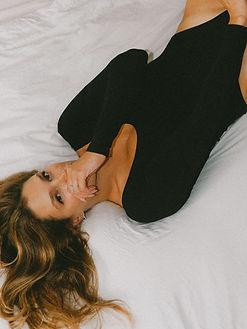Sustainable Fashion Is Taking Over and the Cool Kids Are on Board
- R A E

- Oct 29
- 5 min read

Fashion has always moved fast. Trends come and go, and before you’ve fully decided whether you love a look, it’s already old news. For years, that pace made fast fashion feel unavoidable. Zara, H&M, and Forever 21 made it so easy: a new top every week, a fresh dress for every event, a constant cycle of consumption that almost felt effortless. But there was something missing. The more I shopped in that loop, the more I noticed the sameness. I’d see five other people wearing the exact same Zara top at brunch, at work, on Instagram. It made me start questioning why I was spending money on clothes that didn’t feel like mine. That’s when the mental shift happened. I didn’t just want sustainability because it sounded good, I wanted my clothes to be a reflection of me, something distinctive, something intentional.
Fast fashion had trained me to think that ease equals style, but I realized that true style comes from pieces that carry meaning, care, and a touch of individuality. And that’s where sustainable fashion started to feel not just like the right choice, but the cooler choice.
From Necessity to Desire
At first, the shift wasn’t easy. Sustainable fashion often requires more thought. Shopping secondhand, investing in higher-quality fabrics, or supporting ethical brands takes planning. But the payoff is undeniable. Unlike a mass-produced top that disappears after a month, these pieces last longer, look better over time, and actually fit your life. The mental shift came in two layers: first, I wanted uniqueness—clothes that weren’t being worn by everyone else. Second, I wanted responsibility—clothes that felt right in my hands, from sourcing to production.
It wasn’t just a moral choice. It became a style choice. The “cool kids” aren’t just talking about resale as a necessity anymore. Thrifting, upcycling, and investing in ethical brands are cultural signals. When a friend casually mentions they scored a vintage silk blouse at a local market, it sparks curiosity. When an influencer shares a Depop haul that mixes old-school treasures with timeless investment pieces, it feels aspirational. Suddenly, sustainability is aspirational, stylish, and accessible all at once.
Why the Shift Feels So Good
One of the biggest draws of sustainable fashion is how it changes your relationship with your wardrobe. You stop accumulating for accumulation’s sake and start curating for meaning. It’s like walking into your closet and knowing that each item has a story, a purpose, a personality. There’s satisfaction in knowing a piece wasn’t made in exploitative conditions, that the fabrics are better for the planet, and that your style is uniquely yours. It’s slow, intentional, and deeply rewarding.
Sustainable fashion also pushes creativity. When you’re not following the endless churn of fast fashion, you think differently about mixing, matching, layering, and styling. That Zara top everyone has might feel safe, but when you’re hunting for pieces that tell your story, your outfits become richer, more thoughtful, and more personal.
The Role of Culture in Sustainability
What’s really fascinating is how culture is helping sustainable fashion thrive. It’s not just about environmental benefits anymore. It’s about identity, social signaling, and community. Platforms like Depop, Vestiaire Collective, and ThredUp have made secondhand shopping a statement rather than a compromise. Even luxury brands are getting in on the action. When Reformation collaborates with celebrities or when resale platforms like Vestiaire Collective land spots on shows like Emily in Paris, sustainability becomes trendy, visible, and culturally aspirational. People aren’t just buying clothes; they’re signaling taste, values, and belonging.
This cultural shift matters more than you might think. It transforms sustainable fashion from an idea into a movement, from a moral choice into a visible, desirable lifestyle. It makes people want to participate and share, creating a feedback loop that propels sustainability forward in the mainstream.
Despite the excitement, sustainable fashion isn’t without its hurdles. High-quality fabrics and ethical production often come with higher price tags. Slow fashion requires patience, creativity, and effort that fast fashion never demands. Not every sustainable brand gets it right either—some are greenwashing, some aren’t fully transparent, and some struggle to scale. There’s also the challenge of consistency. It’s easy to buy one sustainable piece and feel good, but making intentional choices a habit takes discipline.
Yet the effort pays off.
Once you start curating your wardrobe thoughtfully, the pieces last longer, feel better, and actually match your lifestyle. The clothes aren’t just garments; they’re investments in your personal style and the planet.
My Experience with Sustainable Fashion
Personally, making the shift felt revolutionary. I started by replacing a few fast fashion items with secondhand treasures and higher-quality ethical brands. Soon, the difference was obvious. Clothes fit better, held up longer, and felt more “me.” I could wear them more than once without feeling guilty, and every outfit became an exercise in creativity. I wasn’t just following trends; I was building a wardrobe that reflected my taste, values, and personality.
It also changed how I approached shopping. No more impulse buys, no more racks of identical tops. Each purchase became a decision, a statement, a little story I could tell. And yes, the aesthetic is undeniably cooler. It feels satisfying to know that fashion can be aspirational without being wasteful, that style and sustainability can coexist effortlessly.
What I Like
I love the thoughtfulness sustainable fashion encourages. It makes me more conscious of what I wear, how I wear it, and the story it tells. It’s empowering to know that my choices support ethical production, creativity, and individuality. I enjoy discovering unique pieces, mixing vintage with modern, and curating a wardrobe that evolves with me instead of following the next trend blindly.
The social aspect is fun too. Platforms like Depop and Vestiaire Collective turn shopping into a community experience. Sharing finds, swapping pieces, and seeing others do the same adds joy to fashion. It feels like a movement rather than just a purchase.
What Could Be Better
The biggest challenge is accessibility. Sustainable fashion often comes at a premium, which can be limiting. It takes time to find the right pieces, and patience is required. Some brands overpromise on sustainability, and it can be hard to distinguish between truly ethical options and greenwashing. There’s also a learning curve in sizing, materials, and sourcing, which might intimidate some shoppers.
Despite this, every effort to make sustainable choices counts. Even small steps, like buying one vintage item a month or prioritizing quality over quantity, contribute to a bigger shift. The key is persistence and willingness to experiment.
Sustainable fashion isn’t just a trend; it’s a movement reshaping how we think about style, identity, and consumption. The shift wasn’t easy, but the payoff is transformative. Clothes become more than fabric; they’re statements, stories, and investments in the world we want to live in.
The cool kids are on board, but it’s deeper than culture—it’s about intention, individuality, and a wardrobe that lasts. Once you make the switch, it’s hard to go back. Fashion can be beautiful, meaningful, and sustainable all at the same time, and that is a style statement worth making.
Love,
Rae
Image Credits - Mayara Caroline Mombelli




















.jpg)
Comments